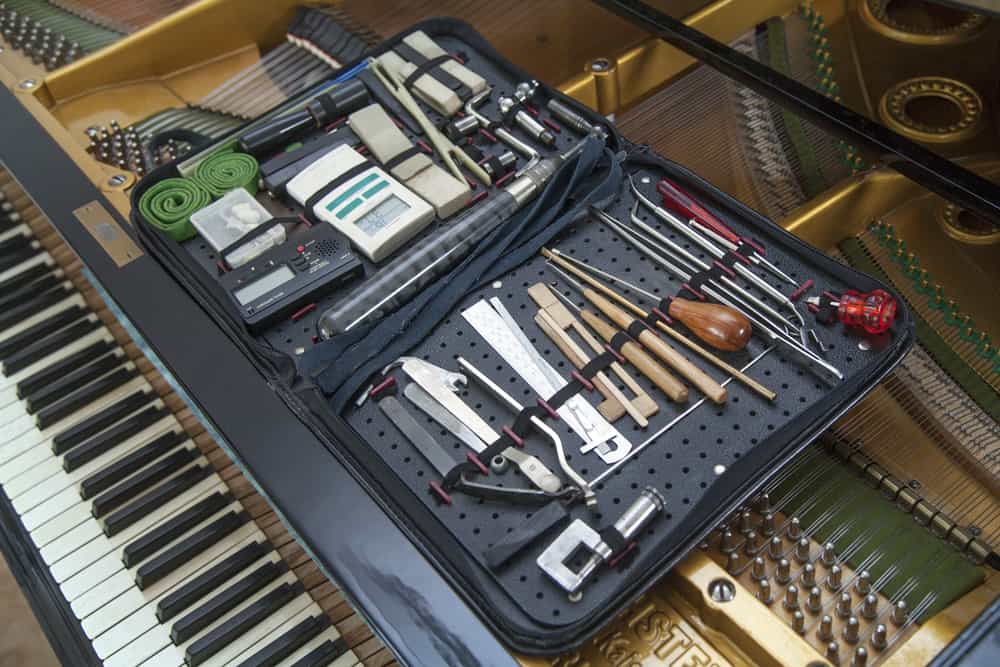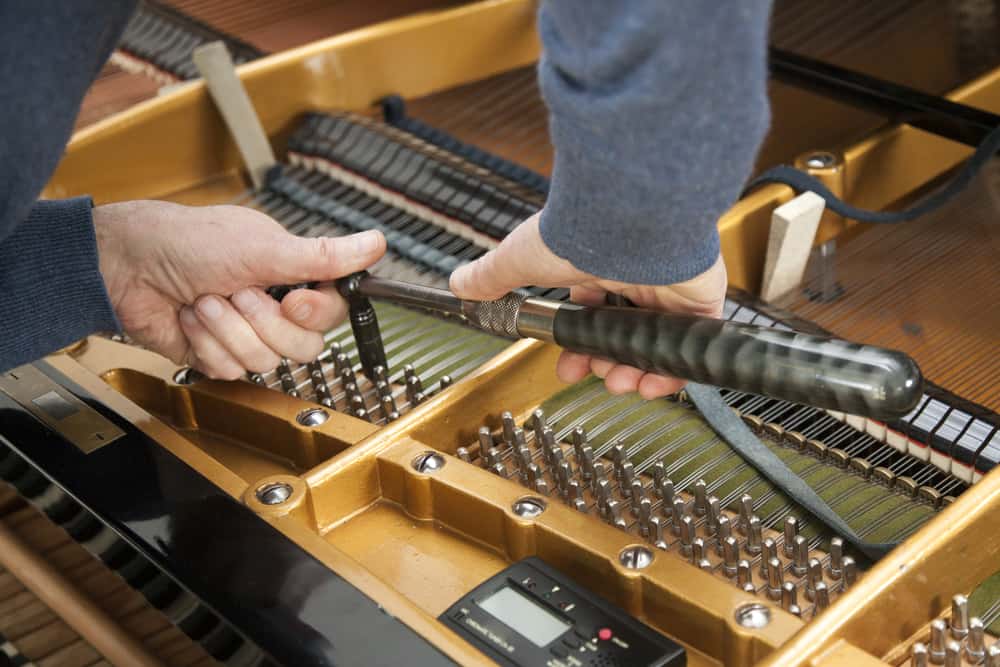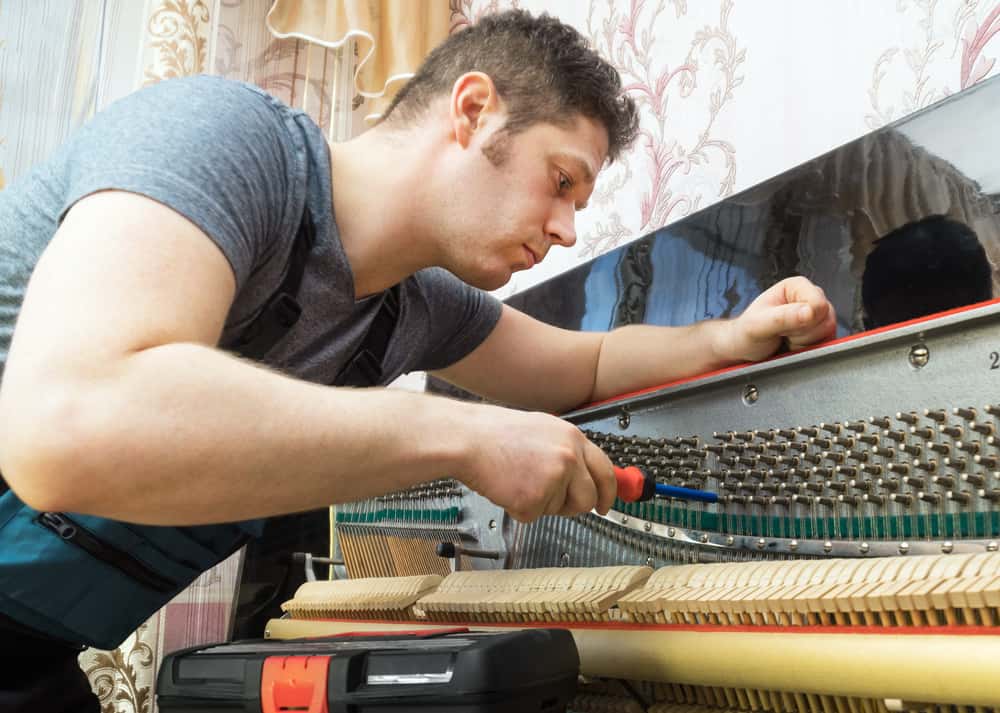Almost every single instrument you own requires some form of maintenance, whether it’s your guitar, your saxophone or your piano. Just like a car, instruments need to be serviced from time to time in order to ensure that they are functioning properly. This is why we change guitar strings or tune our pianos.
The first thing many people think about when they have an out of tune piano is how can I tune my piano and how much will it cost to tune a piano? In this article, we answer those questions and we take into account piano tuning cost factors and explain how to maintain your piano’s tuning.
All prices are given as an estimation and a rough guide. Prices will differ depending on your piano technician of choice.
What is Tuning?
Tuning may just be the most important aspect of piano maintenance but it is often overlooked or simply misunderstood. To help you better understand, we’re going to define what ‘tuning your piano’ refers to.
Pianos have a standard tuning of A440 and this simply means that the A above the Middle C should vibrate at 440 cycles per second, otherwise referred to as 440Hz. During tuning, piano technicians adjust the piano’s tuning pins so as to ensure that all the strings have the right tension or the right pitch. This, in turn, gives off the right musical interval (an interval refers to the difference in pitch between two notes).
A piano has 88 keys and the average piano has 230 strings. The technician will adjust the tension of each string until they are in the tuning of A440 (as mentioned earlier this is the standard tuning of pianos).
Why Should I Tune my Piano?
Over time, the strings in your piano can stretch as a result of tension. This, in turn, results in your piano going out of tune; the strings will no longer produce the correct pitch and your playing will sound ‘off’. Once a piano goes out of tune you will need to have the combined string tension restored to A440. This is the main reason why pianos get tuned.
One of the main reasons pianos go out of tune is due to seasonal changes and changes in climate. The piano is made out of wood and as such it is subject to expanding and contracting as a result of the climate going from hot to cold or from dry to wet. Temperature changes will have an effect on the tone, pitch and action response of the piano.
Servicing your piano, including tuning it, will help you maintain your piano and ultimately save on expensive repairs in the future. Putting off regular servicing will only lead to the inevitable and you may end up with a rather costly bill due to all the work that needs to be done to your piano.
How Often Should I Tune my Piano?
How often you tune your piano will depend on a number of factors such as the variations in humidity in different environments, how regularly you use your piano, what you use it for and of course your budget.
As a general rule of thumb, it is recommended to tune your piano at least two to four times a year. This may be more depending on your usage of the piano e.g. a recording studio will have its piano tuned much more frequently than a piano used at home. This is because it is in constant use, not to mention that the recordings must be of the highest quality with accurate pitch.
When it comes to new pianos, the recommendation is that they should be tuned a minimum of four times in a year so as to ‘break them in’ (we also discuss breaking in your new piano in this article). The reason for this is because of string settling and stretching. Tuning your new piano regularly in the first year will compensate for this.
Differing piano manufacturers have various recommendations for how often you should tune and we discuss this towards the end of the article.
Piano Tuning Cost Factors
While each instrument will have its own particular needs that will influence the cost of tuning, there are some general factors that the piano technician will consider when appraising the needs of your instrument.
These include:
- The type of piano you own,
- How regularly your piano has been maintained,
- Whether or not there are any broken strings,
- How old the piano is,
- Whether there needs to be more repairs.
Another factor that will affect the overall cost of tuning your piano will be your location. While this doesn’t necessarily have anything to do with the actual instrument, your proximity to a technician is something that will factor into the overall cost due to travel costs. You may have a technician come from out of town, or you may have to arrange for transport to your service center of choice.
Types of Piano Tuning
There are several types of piano tunings and these will ultimately dictate how much you would have to part with when paying your technician to tune your piano. Below we explore the different types of piano tunings.

For the sake of simplicity, technicians may categorize the different types of tunings as ‘levels’ and divide them into four different categories.
The different levels are:
- Level 1: Basic tuning service
- Level 2: Operative maintenance service
- Level 3: Sore arm tuning
- Level 4: Dead on arrival pianos (DOA)
Level 1: Basic Tuning Service
This category covers pianos that are maintained regularly (by regularly we refer to a tuning every six months to a year). These jobs fall under the ‘basic tuning service’ category as they typically take the technician 1hr to 1hr 30mins to complete tuning.
Typically speaking, the cost to tune a piano under this category with a high-quality technician will be $110 – $150 for 1 tuning.
More pocket-friendly options may be available and some technicians may ask for anywhere between $65 – $90. Ultimately you will have to research your local piano technicians until you find the most cost-effective choice for your budget.
Level 2: Operative Maintenance Service
In a nutshell, this level will apply to the ‘moderately’ maintained piano. These are typically pianos that have recently been moved (shifting a piano will affect the tuning) and pianos that have not been tuned in two years.
Under this category, your piano technician will need to turn all the tuning pins one time so as to pressurize the sound before they do the actual tuning. As each of the 230 pins must be tuned, this process takes around 1hr45 to 2hrs and costs $160 – $220.
Level 3: Sore Arm Tuning
This will generally apply to the pianos that have been ignored for a lengthy period of time and are generally very flat in tuning. The term ‘sore arm’ refers to the amount of work required to restore the piano to a playable condition. This type of tuning will typically also be applied to older instruments i.e. those that are 60 years or older.
The process will involve the technician doing two-pitch raises followed by a basic tuning. The process usually lasts 2hr 30mins and will cost an estimated $220 – $400 due to the work involved and the level of care that must be maintained. This estimate will vary on the type of model as some technicians may charge more for older spinet models.
Fun fact: this type of tuning accounts for nearly a sixth of the pianos that technicians work on.
Level 4: Dead On Arrival
As the name suggests, this category applies to pianos that are full of defects and badly damaged to the point why they physically cannot be tuned. There is usually no merit in trying to tune pianos that fall under this category and more often than not your technician will advise you of the same.
Although a dead on arrival piano cannot be tuned, technicians may nevertheless charge for providing the inspection service and this could set you back anywhere between $40 – $80.
In the chance your piano falls under this category then you would be better off simply purchasing a new piano and maintaining it to the best of your abilities.
Advanced Tuning Services
As each situation is different, some pianos may need more work than others and in such instances, the piano technician may suggest an advanced tuning service. This is usually more detailed than the other options and the technician will spend more time with the piano in such a situation.
Apart from tuning, the technician may be required to voice the hammers for a better tone, a soundboard might be dirty or they may need to apply lubrication to certain parts, amongst other things.
This service is often billed as a “full-day” job meaning it would take roughly 8 hrs or so. Depending on your technician of choice, this can cost you anything from $600 – $1000.
Maintaining Piano Tuning
Temperature and Humidity
As discussed earlier in this article, temperature and humidity will affect the tuning of your piano. Although there is little you can do to prevent climate change, you can ensure that the environment your piano is in is conducive for it to maintain its tuning.
Warmer months tend to be more humid and will result in the piano wood absorbing moisture from the atmosphere and swelling. This results in the strings tightening which then raises the pitch. During the colder months, the water will evaporate from the wood if heating is used and this will result in the strings slacking and the pitch dropping. Your soundboard may crack if this cycle becomes too extreme.
You should strive to avoid sudden changes in temperature by maintaining constant values. A temperature of 72 °F and humidity of 45 °RH is recommended (programmable humidifiers are available for purchase online)
Age of Piano & Tuning History
How new or old your piano is will influence the tuning of your piano. For instance, new pianos should be tuned a minimum of six times before they are considered to be ‘broken in’. Breaking in a piano is crucial otherwise it will not be able to hold its pitch for sustained periods of time.
Regularly tuning a new piano over and over is the most effective way to break it in as there is no practice exercise that requires all the notes in your piano to be played at once. Tuning works all the piano keys equally.
Older pianos tend to go out of tune rather quickly as a result of the state of the tuning pins and the pin block.
Warranty Considerations
Most piano manufacturers will mention how often they recommend you tune your piano. It is important to pay attention to these instructions in order to adhere to your warranty agreement with the manufacturer. Given the rather inexpensive nature of pianos, we highly recommended that you keep your warranty valid in case you have to use it.
Moving Your Piano
Different people have different opinions on whether or not moving your piano will affect its tuning. Although moving the piano itself may not alter the tuning, moving the piano to a new environment with different atmospheric conditions will result in the tuning changing due to changes in heat and humidity. If this is the case then you will need to have the piano tuned every few weeks until it ‘settles’ into the new location.
Finding the Right Piano Technician
By now this article has given an idea of how much you will need to spend when having your piano tuned. Although these are estimates, they give a ball-park figure so you have a budget in mind and don’t get over-charged by any unscrupulous characters.
With your budget set, you now need to find a reputable piano technician. The simplest place to start would be a quick Google search relevant to your particular town/city. Most professional technicians have websites that inform you of their charges and their working hours.
Alternatively, you can get in touch with other musicians and ask them for recommendations. This is time effective as you don’t have to spend too much time searching for a technician. You can also rest assured you are working with a reliable technician since they have been recommended by someone you know.
Although there is no universal database for all the piano technicians in the world, The Piano Technician’s Guild has a registry that allows people to search for piano technicians by postal code, country or services required.
Worth noting is that not all piano technicians will charge you a flat rate fee, some operate on an hourly basis. This varies from technician to technician. Piano tuning hourly rates may start from $100 but some technicians may charge more depending on the type of piano i.e. grand pianos and concert pianos will typically cost more than other pianos.
What the Manufacturers Say
Yamaha: New pianos should be tuned a minimum of four times the first year to compensate for the normal settling that takes place. Subsequently, as a matter of standard maintenance, a piano should be tuned at least twice a year.
Steinway & Sons: We recommend that your technician be called at least three or four times a year. You, however, are the final judge and should have the piano tuned as often as you think necessary. To put the matter of tuning into perspective, remember that a concert piano is tuned before every performance, and a piano in a professional recording studio, where it is in constant use, is tuned three or four times each week as a matter of course.
Tuning is an art practiced by skilled professionals and under no circumstances should anyone other than a professional be allowed to tune your Steinway piano.
Baldwin Piano Company: Professional service is the key. In the first year, the National Piano Manufacturers Association recommends that you have your piano tuned four times. This is a period of environmental adjustment for a new instrument, and proper attention is important.
After the first year, the piano should be tuned at least twice each year, depending upon the frequency of use and atmospheric conditions.
Schimmel: As a rule, a brand new piano should, depending on its location and climatic conditions, be tuned two to three times in the first year or two. An instrument played often and intensely could require additional tunings.
Conclusion
- You should tune your piano every six months.
- New pianos must be tuned at least four times during their first year of use.
- A new piano is considered to be ‘broken in’ once it has been tuned at least six times.
- Tunings can range from $60 – $400 depending on the type of tuning and the technician you use.
- Maintaining constant levels when it comes to the temperature and the humidity will allow your piano to stay in tune, maintain it in an air-conditioned area if you can.
- Keep your piano closed when it is not in use.
- Always use a qualified piano technician (otherwise you may end up with more problems than an out of tune piano!).


